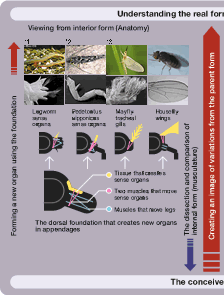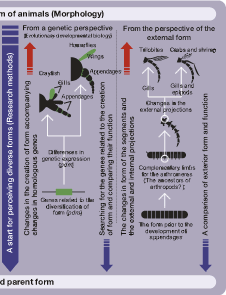Observe the rigidity of a crab's claw, the whip-like sensory tentacles of shrimp, and the explosive leaping ability of the grasshopper. Form and function are completely different, but in each case they represent changes in the homologous organs that are appendages. The evolutionary process creates a wide variety of forms, but there are no examples as diverse and as adapted to the environment as arthropod appendages.
This is the suitable model for the study of the mechanism of the evolution of form. It's not possible to see the similarities when looking at a crab's claw or a grasshopper's leg, however. We posed the questions, what are appendages, and what is the essence.
Appendages are related to the environment, and attention focuses on the important musculature system during active movement. The lugworm, pedetontus nipponicus, the mayfly, and the housefly have appendages that are quite dissimilar, from annulated animals to arthropods. We have repeatedly dissected them, sketched them, and dyed tissue sections. As a result, two muscles emerged that all have in common - including those that have been lost, but are thought to have definitely existed. The foundation that created organs that move based on the autonomous control of the appendages came into view. The key to evolution might well be how this foundation is utilized. We are pursuing this research from the perspective of form and genes. |

